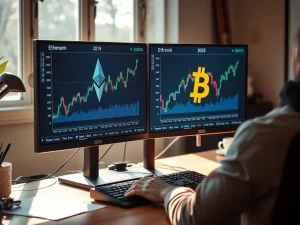Bitcoin’s Monumental Surge: Past $119,000 Driven by Unprecedented Institutional Adoption

The cryptocurrency world is abuzz with groundbreaking news: Bitcoin has shattered expectations, soaring past the $119,000 mark. This isn’t just another price pump; it’s a clear signal of a maturing market, fueled by an unprecedented wave of institutional Bitcoin adoption and profound macroeconomic shifts. For anyone tracking the pulse of digital assets, this moment is nothing short of revolutionary.
The Bitcoin Price Surge Explained: What’s Driving the Momentum?
On July 24, 2025, Bitcoin etched a new milestone into its history, reaching an astounding $119,015.21 on the Binance USDT market. This remarkable **Bitcoin price surge** is not accidental but rather the culmination of several powerful forces converging to redefine its position in the global financial landscape. Understanding these drivers is key to grasping Bitcoin’s current trajectory and future potential.
Institutional Influx: The Power of Spot Bitcoin ETFs
One of the most significant catalysts for this rally has been the widespread approval and success of spot Bitcoin Exchange-Traded Funds (ETFs). These regulated financial products have opened the floodgates for traditional finance, offering institutions a streamlined, compliant, and familiar pathway to gain exposure to Bitcoin without the complexities of direct asset custody. Here’s why this is a game-changer:
- Accessibility: ETFs make Bitcoin accessible to a much broader range of investors, including pension funds, endowments, and wealth management firms, who previously faced regulatory or operational hurdles.
- Legitimacy: The approval of these ETFs by major financial regulators lends an unprecedented level of legitimacy to Bitcoin as an asset class, eroding past skepticism.
- Liquidity: ETFs contribute to increased market liquidity, making it easier for large players to enter and exit positions without significantly impacting prices, thereby stabilizing market dynamics.
Macroeconomic Tailwinds: Bitcoin as Digital Gold
In an era marked by persistent inflationary pressures and concerns over currency devaluation, investors are actively seeking robust hedges against economic uncertainty. Bitcoin, with its capped supply of 21 million coins and decentralized framework, increasingly fits this bill. It is being widely recognized as a scarce digital store of value, earning it the moniker of ‘digital gold.’ As central banks continue quantitative easing policies and global debt levels rise, the appeal of a deflationary, permissionless asset like Bitcoin only grows stronger. This fundamental shift in macroeconomic sentiment has significantly amplified Bitcoin’s demand.
The Halving Effect & Supply Dynamics
The Bitcoin halving event, a programmed reduction in the reward miners receive for validating transactions, is a crucial supply-side factor. Historically, these events—occurring approximately every four years—have preceded significant bullish momentum by effectively constricting the new supply of Bitcoin entering the market. Combined with surging demand from both institutional and retail investors, this supply-demand imbalance creates a powerful upward trajectory. The anticipation and realization of the latest halving have played a pivotal role in fueling the current rally, reinforcing Bitcoin’s inherent scarcity model.
Institutional Bitcoin Adoption: A Game Changer for Legitimacy
The narrative around Bitcoin has fundamentally shifted from a niche speculative asset to a recognized strategic holding, largely due to accelerating **institutional Bitcoin adoption**. This isn’t just about large corporations adding Bitcoin to their balance sheets; it’s about a systemic integration into traditional financial infrastructure.
Who’s Buying and Why?
A diverse range of institutional players are now actively allocating capital to Bitcoin:
- Asset Managers: Major asset management firms are including Bitcoin and Bitcoin ETFs in their diversified portfolios, offering clients exposure to this burgeoning asset class.
- Corporations: Forward-thinking corporations are holding Bitcoin as a treasury reserve asset, viewing it as a superior alternative to depreciating fiat currencies.
- Hedge Funds: Sophisticated investment funds are leveraging Bitcoin’s volatility and growth potential through various strategies, including long-term holding and derivatives trading.
- Family Offices: High-net-worth individuals and family offices are increasingly turning to Bitcoin as a hedge against inflation and a long-term growth asset.
This widespread adoption signals a growing consensus on Bitcoin’s enduring value proposition and its potential to diversify traditional portfolios, reinforcing its legitimacy and paving the way for further mainstream acceptance.
Navigating Cryptocurrency Market Trends Amidst Growth
While the **Bitcoin price surge** is cause for celebration, understanding broader **cryptocurrency market trends** is essential for any informed investor. Bitcoin’s dominance often acts as a barometer for the entire crypto ecosystem, influencing altcoin performance and innovation.
Understanding Bitcoin’s Volatility
Despite its growing maturity, Bitcoin’s volatility remains a critical characteristic. Price swings of 10-20% within short timeframes are not uncommon. This necessitates disciplined risk management strategies. While such fluctuations can be daunting, they are inherent to a relatively young, rapidly evolving asset class. Investors should prepare for these movements and avoid making emotional decisions based on short-term price action.
Regulatory Landscape: A Path to Clarity
Regulatory uncertainty has long been a significant hurdle for the crypto market. However, the trend is towards greater clarity. Governments worldwide are actively refining digital asset frameworks, moving from a reactive to a more proactive stance. While challenges persist, the increasing dialogue between regulators and industry participants suggests a future with clearer guidelines, which will further de-risk institutional involvement and foster innovation.
Bitcoin’s Dominance and Altcoin Seasons
Bitcoin’s performance often dictates the flow of capital across the broader crypto market. When Bitcoin experiences a significant rally, it typically attracts new capital into the ecosystem. A portion of this capital then often flows into altcoins, leading to what is popularly known as an “altcoin season,” where alternative projects experience substantial gains. This dynamic underscores Bitcoin’s foundational role and its ability to stimulate innovation across decentralized finance (DeFi), NFTs, and other blockchain protocols.
The Role of Bitcoin ETFs in Mainstream Integration
The advent of spot **Bitcoin ETFs** has been a pivotal moment in the asset’s journey towards mainstream financial integration. They have not only provided a new investment vehicle but have also significantly altered market dynamics.
Accessibility and Liquidity
Bitcoin ETFs offer unprecedented accessibility. They can be bought and sold on traditional stock exchanges, just like any other stock or mutual fund. This ease of access removes many of the technical barriers associated with buying and storing actual Bitcoin, such as setting up wallets or dealing with complex exchange interfaces. Furthermore, the substantial trading volumes associated with ETFs contribute to enhanced market liquidity, making large-scale transactions more efficient and less impactful on price.
Future Implications
The success of Bitcoin ETFs is likely to pave the way for similar products for other major cryptocurrencies, further blurring the lines between traditional finance and the digital asset space. This integration will lead to increased institutional participation, greater market efficiency, and ultimately, a more mature and robust cryptocurrency ecosystem.
Bitcoin: The New Digital Gold in an Uncertain Economy?
The narrative of Bitcoin as **digital gold** has gained significant traction, especially in the face of ongoing global economic uncertainties. Its properties make it an increasingly attractive alternative to traditional safe-haven assets.
Inflation Hedge and Store of Value
In an environment where central banks are expanding money supplies and governments are accumulating unprecedented levels of debt, the purchasing power of fiat currencies is constantly under threat. Bitcoin’s fixed supply and decentralized nature make it immune to such inflationary pressures. It serves as a deflationary asset, offering a compelling store of value that cannot be devalued by government decree or central bank policy. This makes it a powerful tool for preserving wealth in the long term.
Global Economic Outlook
As geopolitical tensions rise and global supply chains remain fragile, investors are looking for assets that can withstand economic shocks. Bitcoin’s decentralized framework means it is not tied to any single nation-state’s economy or political stability. This global, borderless nature enhances its appeal as a resilient asset in an increasingly interconnected yet uncertain world.
Conclusion: Bitcoin’s Trajectory – A Blend of Innovation and Caution
Bitcoin’s journey past $119,000 marks a significant epoch in its evolution. Driven by accelerating institutional adoption, supportive macroeconomic tailwinds, and continuous technological advancements like the Lightning Network, its trajectory appears robust. As regulatory clarity continues to emerge and Bitcoin further integrates into global financial systems, its role as a decentralized, scarce store of value is poised to expand dramatically. While the potential for growth is immense, investors are advised to adopt informed, long-term strategies, emphasizing dollar-cost averaging and portfolio diversification, to balance the exciting growth potential with prudent risk management. The future of finance is undeniably intertwined with the decentralized revolution Bitcoin ignited.
Frequently Asked Questions (FAQs)
Q1: What is driving Bitcoin’s recent surge past $119,000?
A1: The surge is primarily driven by a combination of factors including significant institutional adoption (especially through spot Bitcoin ETFs), macroeconomic uncertainties leading investors to seek inflation hedges, the supply-constricting Bitcoin halving event, and continued technological advancements like the Lightning Network.
Q2: How do spot Bitcoin ETFs contribute to institutional adoption?
A2: Spot Bitcoin ETFs provide a regulated, accessible, and familiar investment vehicle for traditional financial institutions like asset managers and corporations. They allow these entities to gain exposure to Bitcoin’s price movements without directly holding the asset, simplifying compliance and custody issues.
Q3: Is Bitcoin still considered a volatile investment?
A3: Yes, despite its growing maturity, Bitcoin remains volatile. Price swings of 10-20% within short timeframes are common. Investors are advised to practice disciplined risk management strategies such as dollar-cost averaging and portfolio diversification to mitigate this volatility.
Q4: What is the significance of Bitcoin being called ‘digital gold’?
A4: Bitcoin is referred to as ‘digital gold’ because, like gold, it is a scarce asset with a limited supply (21 million coins). In times of inflation or economic uncertainty, investors view it as a robust store of value and a hedge against the devaluation of fiat currencies, due to its decentralized and deflationary nature.
Q5: How does Bitcoin’s performance impact other cryptocurrencies?
A5: Bitcoin often acts as a bellwether for the broader cryptocurrency market. Its rallies tend to attract new capital into the ecosystem, which can then flow into altcoins, leading to periods known as ‘altcoin seasons’ where alternative projects experience significant gains. Bitcoin’s dominance can drive overall market sentiment and innovation.
Q6: What should investors consider before investing in Bitcoin now?
A6: Investors should conduct thorough research, understand Bitcoin’s inherent volatility, and consider their risk tolerance. Adopting long-term strategies like dollar-cost averaging, diversifying their portfolio, and staying informed about regulatory developments are crucial for navigating the market effectively.










